JAPAN’S NAVY SAVAGES U.S. PACIFIC FLEET
Pearl Harbor, Hawaii • December 7, 1941
On this date in 1941, a quiet Sunday morning on the Hawaiian island of Oahu just before 8 o’clock, Japan staged a devious, vicious, unprovoked air and naval attack on America’s doorstep, the U.S. naval base at Pearl Harbor and its defending Army Air Corps and Marine airfields that dotted the harbor perimeter. Twelve days earlier, on November 26, over 30 vessels of the Japanese First Air Fleet, among them 6 aircraft carriers with over 420 embarked planes, left Japanese waters on a 3,400‑mile/5,472‑km journey for a point 250 miles/402 km north of the Hawaiian Islands. The most powerful carrier task force yet assembled sailed into history under the command of 54‑year-old Vice Adm. Chūichi Nagumo.
Japan’s spectacular success in the surprise attack on Pearl Harbor nearly 8½ decades ago eviscerated the U.S. Pacific Fleet, removing 60 percent of the U.S. Navy’s capital ships from combat service in a single morning. By the afternoon of December 7, 1941, “a date which will live in infamy” as an enraged President Franklin D. Roosevelt called it, 8 great battleships lay burning or settled on the harbor bottom along with 11 cruisers, destroyers, and other ships sunk or damaged. (By sheer good fortune, the fleet’s aircraft carriers, which soon would play a decisive role in turning the tide against Japan at Midway the following June, were at sea.) More than 340 Army and Navy aircraft were destroyed or damaged. The Japanese assault on Pearl caused injuries and deaths to over 3,600 U.S. sailors, Marines, airmen, soldiers, and civilians, many of the victims entombed for eternity in ships such as the USS Arizona and USS Utah; another 1,178 were wounded. On the Japanese side, losses were modest: 64 airmen killed, 5 vessels sunk, and 29 planes destroyed.
Japanese leaders envisioned a rapid and victorious conclusion of hostilities after inflicting catastrophic losses on America’s Pacific fleet and seizing with relative ease U.S., British, and Dutch holdings in Southeast Asia and the South Pacific. The 4‑month string of tactical naval and ground victories dissuaded an initially cautious and conservative Emperor Hirohito (posthumously referred to as Emperor Shōwa) from looking to end the Asia Pacific war through a combination of diplomacy, third-party mediation, and military successes to military successes alone, which suited the Japanese Imperial Navy just fine.
However with Japan’s disastrous naval defeat at the Battle of Midway (June 3–7, 1942), what initially appeared as a temporary setback turned into the beginning of a long retreat for Hirohito’s navy and its carrier aviation. Of Adm. Nagumo’s 6 aircraft carriers that participated in the Pearl Harbor attack, 4 were sunk at Midway, the fifth, Shōkaku, in the Battle of the Philippine Sea (June 19–20, 1944), and finally Zuikaku in the largest naval battle in history, the Battle of Leyte Gulf (October 23–26, 1944), along with 25 other Japanese front-line warships. After the Battle of Leyte Gulf ended the offensive capability of Japan’s once-feared First Mobile Fleet (Dai-Ichi Kidō Kantai), American sailors began mocking the entire Japanese Combined Fleet as the “immobile fleet.” It seemed to many observers to be a righteous comeuppance to what had been the second most powerful navy in the Pacific Theater in World War II and the third largest navy in the world after the U.S. and Royal navies.
![]()
Day of Infamy: Pearl Harbor, Hawaii, December 7, 1941
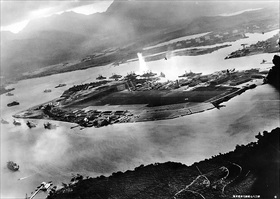 | 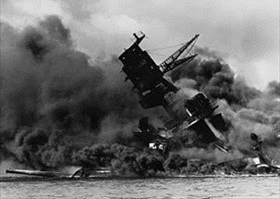 |
Left: Photograph taken by a Japanese airman of Pearl Harbor’s Battleship Row (center in photo) on the east side of Ford Island during the first of 2 attack waves, one at 7:48 a.m., the other an hour later. The geyser of water is next to the USS Oklahoma. Of 8 battleships in the harbor, the attack destroyed the USS Arizona, sank the USS California and the USS West Virginia at their moorings, and caused the USS Oklahoma, struck by 9 torpedoes, to capsize onto her port side, her masts touching the shallow harbor bottom. Over the next couple of days 32 trapped sailors were freed when holes were cut into the hull of the capsized ship; 429 crewmen perished. The USS Nevada was forced to beach and 3 battleships were damaged but remained afloat: USS Pennsylvania, whose crew managed to fire antiaircraft weapons and .50 caliber machine guns at enemy planes, USS Tennessee, and USS Maryland. Additionally, the 2‑wave attack severely damaged 9 other warships, destroyed 188 aircraft, and killed 2,335 U.S. servicemen and 68 civilians. The greatest loss of life occurred aboard the USS Arizona, which lost 1,177 sailors and Marines; just 335 men survived the air attack.
![]()
Right: Hit by an armor-piercing bomb, the forward magazines of the USS Arizona exploded, sending crew and battleship, its keel broken in half, to the harbor bottom just 14 minutes after the Japanese attack began that fateful morning. The supporting structure of the forward tripod mast collapsed after the magazine exploded. Those who were blown or jumped overboard on this ship and others who were the target of enemy artillery, bombs, and torpedoes often swam through thick burning oil, hot, smoke-filled air, and the dead and dying to reach safety. The Arizona burned for 2 days. Today the sunken ship is a war memorial that commemorates the “initial defeat and ultimate victory” of all lives lost on December 7, 1941.
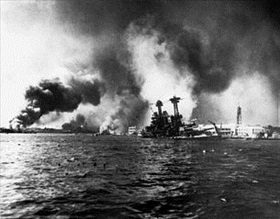 | 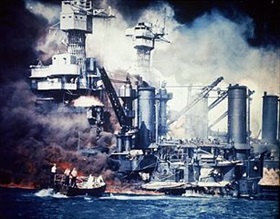 |
Left: The battleship USS California is seen slowly sinking alongside Ford Island, Pearl Harbor, as a result of bomb and torpedo damage that killed 100 sailors. The battleship was able to open fire on the first of the 2 waves of Japanese naval aircraft. The destroyer USS Shaw burns in the floating dry dock in the left distance. The battleship USS Nevada is beached opposite Hospital Point in the left-center distance, having lost 60 men in the attack. The California, rebuilt at the Puget Sound Naval Shipyard in Washington state, returned to service in January 1944, the Shaw in June 1942, and the Nevada in October 1942.
![]()
Right: The battleship USS West Virginia took 2 aerial bombs, both duds, and 7 torpedo hits into her port side, one of which may have come from a Japanese midget submarine. Sailors in a motor launch are pictured rescuing a survivor from the water alongside the sunken ship during or shortly after the attack, which killed 106 men. The West Virginia returned to service in July 1944. She and the light cruiser USS Detroit were the only Pearl Harbor survivors to take up station in Tokyo Bay the next September when Japan signed the surrender document. The battleship USS Tennessee, which lost 5 seamen in the attack, is visible behind the West Virginia. The Tennessee returned to service in February 1942, rejoining the fleet in June.
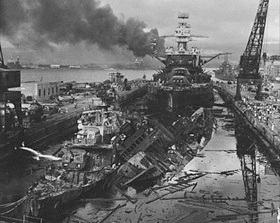 | 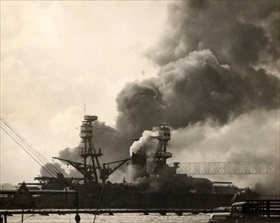 |
Left: Admiral Husband E. Kimmel’s flagship, the World War I era battleship USS Pennsylvania, can be seen in Drydock No. 1 behind the wrecked destroyers USS Downes and USS Cassin at the Pearl Harbor Navy Yard soon after the end of the Japanese air attack. The Cassin, which had had part of its hull removed for dock work, capsized against the Downes. The torpedo-damaged cruiser USS Helena can be seen in the right distance beyond the crane. In the center distance is the capsized Oklahoma with the USS Maryland alongside. The smoke is from the sunken and burning Arizona, out of view behind the Pennsylvania. The California is partially visible at the extreme left. The moderately damaged Pennsylvania, which lost several dozen men while fending off enemy aircraft with antiaircraft fire, underwent immediate repairs at the Puget Sound Naval Shipyard and was overhauled in San Francisco’s Mare Island Naval Shipyard. The warship returned to active service in March 1942. She ended service in July 1946 as a target ship during the atomic bomb tests at Bikini Atoll.
![]()
Right: Hit by 6 bombs and 1 torpedo, which killed 60 men, the World War I battleship USS Nevada is seen attempting to escape from the harbor. The crew beached the ship, which, after repairs and extensive modernization at the Puget Sound Naval Yard, returned to service in October 1942.
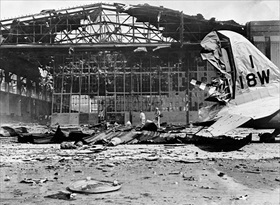 | 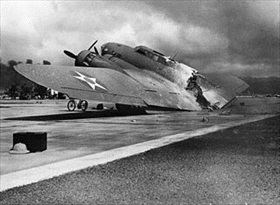 |
Left: Japanese aircrews bombed and strafed Navy air bases at Kaneohe Bay and Ford Island, in the center of Pearl Harbor; Army Air Corps fields at Bellows, Wheeler, and Hickam (shown here); and the Ewa Marine airfield. A total of 188 aircraft were destroyed and 159 damaged.
![]()
Right: A destroyed U.S. Army Air Forces Boeing B-17C Flying Fortress rests near a hangar at Hickam Field, December 7, 1941. Flown from California to Hickam en route to Del Monte Field on the Philippine island of Mindanao, it arrived during the attack. On its final approach, the aircraft’s magnesium flare box was hit by Japanese strafing and ignited. The burning plane separated upon landing. The crew survived the crash.
Frank Capra’s “Why We Fight,” U.S. Government World War II Propaganda Series
![]()

 History buffs, there is good news! The Daily Chronicles of World War II is now available as an ebook for $4.99 on Amazon.com. Containing a year’s worth of dated entries from this website, the ebook brings the story of this tumultuous era to life in a compelling, authoritative, and succinct manner. Featuring inventive navigation aids, the ebook enables readers to instantly move forward or backward by month and date to different dated entries. Simple and elegant! Click
History buffs, there is good news! The Daily Chronicles of World War II is now available as an ebook for $4.99 on Amazon.com. Containing a year’s worth of dated entries from this website, the ebook brings the story of this tumultuous era to life in a compelling, authoritative, and succinct manner. Featuring inventive navigation aids, the ebook enables readers to instantly move forward or backward by month and date to different dated entries. Simple and elegant! Click 











